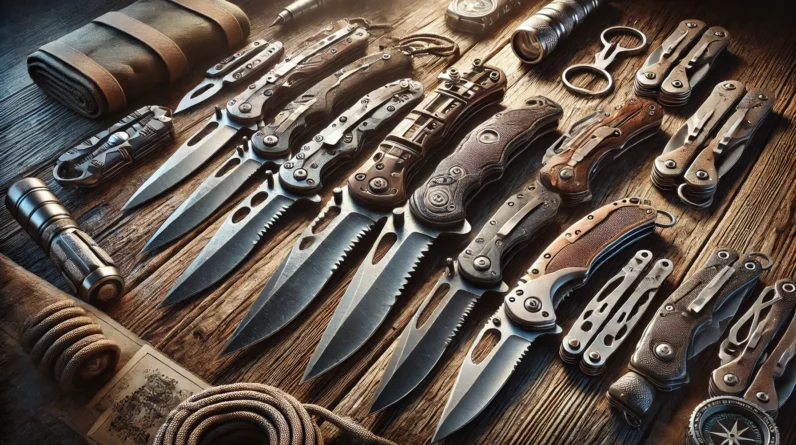
In survival situations, having the right tools can make the difference between life and death. Among these tools, a survival knife stands out as the most essential. It’s more than just a blade; it’s a reliable companion that can assist you in countless survival tasks. Whether it’s cutting cordage, preparing food, building shelter, or even defending yourself, a survival knife is your lifeline. In this guide, we’ll cover everything you need to know about selecting the best survival knife, its key functions, and the features to look for.
This post may contain affiliate links. If you purchase through these links, we may earn a small commission at no extra cost to you. As an Amazon Associate, we earn from qualifying purchases.
Why a Survival Knife is Essential
Your survival knife isn’t just a tool—it’s an extension of your hand in the wild. It’s the ultimate multi-purpose instrument for various survival-related tasks, such as:
- Digging: Clear ground for fire pits or shelter.
- Food Preparation: Cleanly slice and prepare food for cooking.
- Shelter Building: Craft makeshift shelters using available materials.
- Fire Making: Help create kindling and start fires.
- Prying Tool: Open containers or split wood.
- Signaling: Reflect sunlight to signal for help.
- Hammering: Use the knife pommel to drive stakes or break objects.
- Screwdriver Substitute: Handle simple screwing tasks in a pinch.
A good survival knife is versatile, durable, and dependable, making it indispensable for any survival scenario.
What to Avoid When Choosing a Survival Knife
Not all knives are created equal. Some might look appealing but lack the functionality or durability needed for survival. Here’s what to steer clear of:
Avoid Double-Edged Blades
While they may look intimidating, double-edged blades are primarily designed for thrusting rather than chopping or cutting. They tend to have weaker tips and lack versatility, making them unsuitable for heavy-duty survival tasks like batoning wood.
Skip Rambo-Style Knives
Oversized, aggressive-looking knives might seem cool, but they’re impractical for survival. These knives are often too heavy to carry and are more suited for display than real-world use. Their design emphasizes offense rather than functionality.

Features of the Best Survival Knives
Now that you know what to avoid, let’s focus on the features that make a survival knife truly effective:
1. Fixed Blade with Full Tang
Durability is non-negotiable in survival situations. A fixed blade with a full tang design (where the blade extends through the handle) ensures maximum strength. Folding knives, while convenient, lack the reliability needed for heavy-duty tasks and should only be used as backups.
2. Plain Edge vs. Serrated Edge
For survival knives, a plain edge is the way to go. While serrated edges are useful for cutting synthetic materials like ropes or seatbelts in urban settings, plain edges are far more versatile. They’re easier to sharpen in the field and excel at slicing, chopping, and fine-detail work.
3. Blade Shape and Point
A survival knife should have a sturdy point and a practical blade shape.
- Drop Point Blades: These are the gold standard for survival knives, offering strength, durability, and precision for a variety of tasks.
- Curved Edges: A slightly curved edge on the belly of the blade is ideal for slicing and skinning.
Avoid blades with narrow or thin points, as they are prone to breaking under stress.
4. Optimal Blade Size
The ideal survival knife is robust but not unwieldy.
- Blade Thickness: Around 1/8 of an inch for durability without sacrificing versatility.
- Blade Length: Between 4 to 5 inches is perfect for both heavy-duty and precision tasks.
Knives that are too small struggle with larger tasks like batoning wood, while overly large blades are cumbersome and impractical for finer work.
5. Comfortable, Durable Handle
The handle is just as important as the blade. A good survival knife handle should:
- Feel comfortable and secure in your hand, even during extended use.
- Be made from durable materials like G10, Micarta, or rubber.
- Avoid hollow or plastic handles, as they compromise durability.
- Feature a flat or blunt pommel for hammering tasks.
Survival Knife Functions in Action
When equipped with a quality survival knife, you gain a tool capable of handling diverse tasks. Here’s how a survival knife comes into play during emergencies:
- Shelter Building: Clear branches and shape materials to construct a secure shelter.
- Fire Starting: Create shavings for kindling or strike a fire starter.
- Hunting and Food Prep: Skin animals, prepare meat, or cut vegetation.
- Self-Defense: Protect yourself against potential threats.
Final Thoughts: Choose Function Over Style
When selecting a survival knife, prioritize functionality over flashy designs. Forget the fancy Hollywood knives and focus on finding a practical, skillfully-designed tool.
A good survival knife is:
- Reliable and durable.
- Simple yet versatile.
- Designed to perform, not just to look intimidating.
In survival situations, your knife becomes your most trusted ally. Choose wisely, and it will serve as your lifeline, helping you navigate and overcome even the toughest challenges.
By focusing on proven features—like a full tang fixed blade, plain edge, and ergonomic handle—you’ll find a survival knife that’s up to the task. With the right knife in hand, you’re better prepared to face the unexpected.







